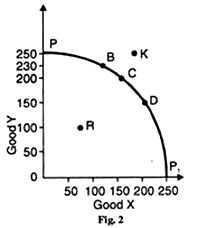Get the answer of: What is Production Possibility Curve?
Since human wants are unlimited and the means to satisfy them are limited, every society is faced with the fundamental problem of choosing and allocating its scarce resources among alternative uses. The production possibility curve or frontier is an analytical tool which is used to illustrate and explain this problem of choice.
The production possibility curve is based on the following Assumptions:
(1) Only two goods X (consumer goods) and Y (capital goods) are produced in different proportions in the economy.
ADVERTISEMENTS:
(2) The same resources can be used to produce either or both of the two goods and can be shifted freely between them.
(3) The supplies of factors are fixed. But they can be re-allocated for the production of the two goods within limits.
(4) The production techniques are given and constant.
(5) The economy’s resources are fully employed and technically efficient.
ADVERTISEMENTS:
(6) The time period is short.
Explanation:
Given these assumptions, we construct a hypothetical production possibility schedule of such an economy in Table 6.1.
In this schedule, P and P1 are such possibilities in which the economy can produce either 250 units of Y or 250 units of X with given quantities of factors. But the assumption is that the economy should produce both the goods. There are many possibilities to produce the two goods. Such possibilities are В, С and D.
ADVERTISEMENTS:
The economy can produce 100 units of X and 230 units of Y in possibility B; 150 units of X and 200 units of Y in possibility C; and 200 units of X and 150 units of Y in possibility D. The production possibility schedule shows that when the economy produces more units of X, it produces less units of Y successively.
In other words, the economy withdraws the given quantities of factors from the production of Y and uses them in producing more of X. For example, to reach the possibility С from B, the economy produces 50 units more of X and sacrifices 30 units of Y; whereas in possibility D for the same units of X, it sacrifices 50 units of y.
Table 1 is represented diagrammatically in Figure 2. Units of good X are measured horizontally and that of Y on the vertical axis. The concave curve PP depicts the various possible combinations of the two goods, P, В, C, D and P. This is the production possibility curve which is also known as the transformation curve or production possibility frontier.
Each production possibility curve is the locus of output combinations which can be obtained from given quantities of factors or inputs.
This curve not only shows production possibilities but also the rate of transformation of one product into the other when the economy moves from one possibility point to the other. The rate of transformation on a production possibility curve increases as we move from point В to С and to D.
The production possibility curve further shows that when the society moves from the possibility point B to С or to D, it transfers resources from the production of good Y to the production of good X.
As put by Samuelson:
ADVERTISEMENTS:
“A full-employment economy must always in producing one good be giving up something of another. Substitution is the law of life in a full-employment economy. The production possibility frontier depicts society’s menu of choices.” This is what McConnell calls the ‘optimum product-mix’ of a society.
Again, all possibility combinations lying on the production possibility curve (such as В, С and D) show the combinations of the two goods that can be produced by the existing resources and technology of the society. Such combinations are said to be “technologically efficient”.
Any combination lying inside the production possibility curve, such as R in Figure 2, implies that the society is not using its existing resources fully. Such a combination is said to be “technologically inefficient”. Any combination lying outside the production-possibility frontier, such as K, implies that the economy does not possess sufficient resources to produce this combination.
It is said to be “technologically infeasible or unobtainable”.

